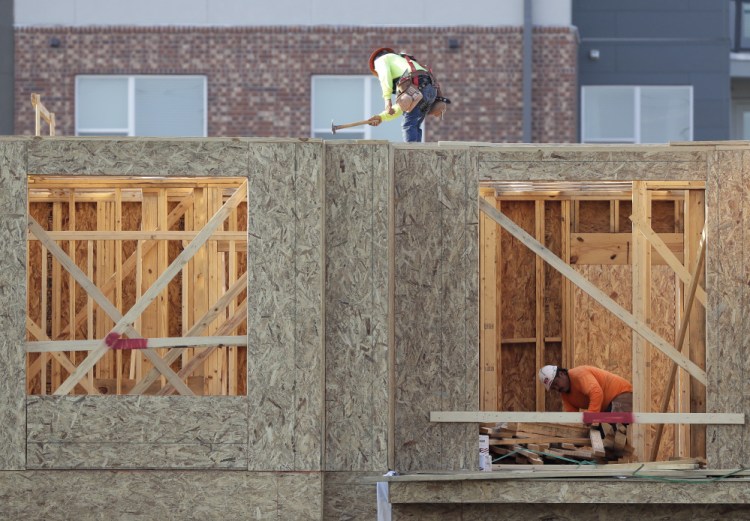WASHINGTON — The U.S. economy revved up this spring after a weak start to the year, fueled by a surge in consumer spending. But the growth spurt still fell short of the optimistic goals President Trump hopes to achieve through tax cuts and regulatory relief.
The Commerce Department said Friday that growth in the gross domestic product, the economy’s total output of goods and services, expanded at a 2.6 percent annual rate in the April-June quarter. That’s more than double the revised 1.2 percent pace in the first quarter.
The improvement was powered in large part by robust consumer appetite for items such as clothing and furniture.
The 2.6 percent GDP gain came in close to economists’ expectations.
“Consumers continue to drive the economy’s growth, but firmer business investment is also a plus,” said Mark Zandi, chief economist at Moody’s Analytics. “Weaker housing construction was the only significant drag on growth in the quarter.”
Trump campaigned on a pledge to boost growth to rates of 4 percent or better. So far, his economic program has not advanced in Congress. But on Friday he still hailed the latest acceleration in growth.
“GDP is up double from what it was in the first quarter – 2.6 percent,” Trump told a crowd in New York. “We’re doing well. We’re doing really well. And we took off all those restrictions.”
Trump told the crowd that he was proud that he had appointed wealthy people to his Cabinet including Commerce Secretary Wilbur Ross and Treasury Secretary Steven Mnuchin.
“I want a rich guy at the head of Treasury. I want a rich guy at the head of Commerce,” Trump told the audience on Long Island. “We’ve been screwed so badly on trade deals. I want people that made a lot of money now to make a lot of money for our country.”
Trump in May put forward a budget for next year that projects growth to steadily advance in the coming years, hitting a sustained pace of 3 percent annually by 2021. The Congressional Budget Office and most private economists are less optimistic, believing growth rates have the potential of improving only slightly from the lackluster rates seen in the current recovery, the weakest in the post-World War II period.
Also on Friday, the department’s Bureau of Economic Analysis issued an annual benchmark revision of its data going back three years. The revision slightly boosted growth over the past three years, enough to lift the average growth in this recovery, now the third longest in U.S. history, to annual gains of 2.2 percent, up from the previous estimate of 2.1 percent.
The 2.6 percent growth in the second quarter was the fastest pace since the economy expanded at a 2.8 percent rate in the third quarter of last year.
Much of the strength in the April-June period came from consumer spending, which grew at a 2.8 percent rate, up from a 1.9 percent growth rate in the first quarter. Consumer spending accounts for 70 percent of economic activity. The economy also benefited far more modest inventory reductions, which was a big drag on first quarter growth.
In the other major categories, business investment in plant and equipment grew at a 5.2 percent rate. But housing construction tumbled at a 6.8 percent rate, a payback after an 11.1 percent surge in the winter due to warmer-than-normal weather. Economists believe housing will resume growing in coming quarters.
A shrinking trade deficit added a modest 0.2 percentage point to growth as exports rose while imports, which subtract from the GDP, grew at a slower pace.
The government sector grew at a 0.7 percent rate, driven entirely by a big jump in defense spending. Domestic federal programs and state and local governments all showed small declines.
Weakness in the first quarter that is followed by a stronger spring expansion has become a familiar pattern in recent years, prompting the government to launch a concerted effort to deal with flaws in the government’s seasonal adjustment process.
Even with the spring rebound, analysts believe the economy will be unable to meet the ambitious targets set by Trump. For this year, many analysts believe growth will come in around 2.2 percent, essentially where growth has been since the recovery began in mid-2009.
During last year’s presidential campaign, Trump attacked the Obama administration’s economic record and said he could jump-start growth through a program of tax cuts for individuals and businesses, regulatory relief, tougher enforcement of trade laws to lower U.S. trade deficits and an increase in spending on infrastructure projects.
But given the fact that the program has failed to advance in Congress, many economists have trimmed their expectations for growth this year, saying any boost from Trump’s efforts will not likely show up until 2018.
The GDP report released Friday was the first of three estimates the government will issue.
Send questions/comments to the editors.



Success. Please wait for the page to reload. If the page does not reload within 5 seconds, please refresh the page.
Enter your email and password to access comments.
Hi, to comment on stories you must . This profile is in addition to your subscription and website login.
Already have a commenting profile? .
Invalid username/password.
Please check your email to confirm and complete your registration.
Only subscribers are eligible to post comments. Please subscribe or login first for digital access. Here’s why.
Use the form below to reset your password. When you've submitted your account email, we will send an email with a reset code.